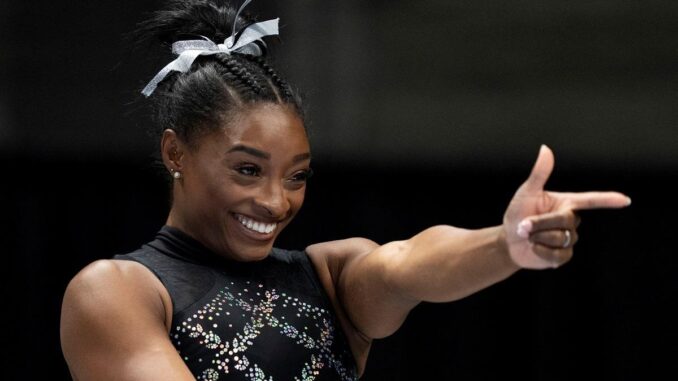
The US women’s team has made sure to keep the spotlight on them for decades. But this year, the men’s team managed to shatter that streak and earned more medals than women for the first time since 1979. Simone Biles stepped into the elite realm in 2013, and since then, it has always been the US women’s team to secure the most medals, be it at World Championships or the Olympics.
In 2021 the American women’s team won three medals in Worlds, which was their lowest since 2012. Even so, there was an explanation for the reduced hall as USAG sent their B team to the event, while their main contenders geared up for the Tokyo Olympics. This time, although Olympian Hezly Rivera withdrew from Worlds owing to an injury, all the expectations were on Joecelyn Roberson, Leanne Wong, and Dulcy Caylor.
Remember when the U.S. women’s gymnastics team seemed unbeatable? The flips, the vaults, the floor routines — it felt like every major competition saw them dominate. But now something’s changed. The men are gaining ground. The women are faltering. And for a program built on decades of success, that shift is both startling and instructive. In this article, we’ll dig into what happened, why it matters, and what the road ahead might look like for U.S. women’s gymnastics.
A Legacy of Dominance – How the Women Built the Program
For many years, the U.S. women’s gymnastics team built a reputation that seemed untouchable. Coaches, athletes, programs — they converged to create a pipeline of all-around stars and apparatus specialists. Think of names like Simone Biles, who became the most decorated female gymnast in history.
This legacy created high expectations: gold medals, multiple apparatus medals, team dominance.
The Recent Decline – What The Numbers Show
Fewer Medals, More Questions
In the most recent world championships, the U.S. women’s team returned with their lowest medal haul since 2001.
And more striking: for the first time since 1979, the U.S. men earned more medals than the U.S. women in a major championship.
That fact alone should set off alarms for any program used to being in front.
Where Did the Golds Go?
A program once flush with gold medals is now facing finals where podium spots simply don’t appear in expected numbers. The absence of top-tier scoring, consistency, and depth has made what once was routine into what now seems fragile.
Root Causes of the Decline
Transitioning Generations
One major factor: the departure or reduced participation of veteran stars. With Biles and other long-standing leaders less active or stepping back, a gap has formed. The next generation is on the rise — but they may not yet have the competitive edge.
This generational shift means less margin for error at elite levels.
Depth and Difficulty Have Dropped
High-level gymnastics is increasingly about difficulty scores and flawless execution. The U.S. women may be coming up short in one or both. Qualifying scores have trended downward relative to rivals.
When you lose your “buffer” of superiority, mistakes are punished.
Men’s Program Rising
At the same time, the U.S. men’s gymnastics program is showing stronger results. A revitalization of talent, improved routines, and perhaps less expectation pressure have allowed men to advance — and to claim medals that until recently seemed out of reach.
This shift flips the usual narrative, making the decline of the women’s dominance more visible.
Structural and Cultural Issues
The broader gymnastics ecosystem might be contributing. Differences in funding, collegiate opportunities, media attention, and athlete lifespan between men’s and women’s gymnastics have been noted.
For example, women often peak earlier, face different pressures, and may have fewer competitive years. That dynamic can strain a program in transition.
The Psychological Impact of Falling Short
When a program accustomed to winning begins to under-perform, the psychological cost mounts. Athletes feel the pressure. Coaches confront scrutiny. The next generation watches, and the “winning culture” suffers.
It’s like a race car built for first place suddenly being challenged by rivals with newer parts — the driver must expect tougher competition, and the car must be upgraded. The U.S. women’s program may be in that upgrade cycle now.
Comparison to the Men’s Program – Why Rising Men Matter
Less Historical Pressure
The U.S. men’s program has long operated in the shadow of the women’s dominance. That lesser spotlight may have allowed them to rebuild without the same pressure.
When you’re underdog, your margin for surprise is bigger; you don’t always have to lead, you just have to improve.
Fresh Talent Emerging
Young male gymnasts are stepping up. They’re adding routines with difficulty, hitting finals, and taking advantage of openings. As the women’s program falters slightly, the men’s successes look brighter in contrast.
Media and Funding Imbalances
Historically, women’s gymnastics got massive media attention (especially around the Olympics) — creating both opportunities and enormous pressure. Men’s gymnastics, less covered, may have developed more quietly, with fewer expectations and more freedom to rebuild — thereby now being in a position to claim more medals.
Why This Matters for the U.S. Women’s Program
Losing Momentum Can Be Dangerous
The moment a dominant program slows, it’s easier for rivals to catch up. Skills evolve, training methods change, and complacency can set in. For the U.S. women, losing the edge now could mean an era of catch-up rather than leading.
Implications for Funding and Recruitment
If results drop, sponsors, media, and young recruits may look elsewhere. Recruitment pipelines weaken, making the regeneration of talent harder. The next generation might not get the same support if the narrative becomes “we used to be great.”
Olympic Consequences
With the 2028 Summer Olympics in Los Angeles on the horizon, this transitional phase for the U.S. women’s team becomes even more critical. A home Olympics raises expectations. If the team isn’t ready, the disappointment will be amplified.
Keys to Recovery – What the Women’s Program Must Do
Cultivate Depth, Not Just Stars
Having one superstar isn’t enough. A team needs multiple athletes ready for finals, with strong routines and mental resilience. The U.S. women must build that bench — not just rely on a few stars.
Increase Difficulty While Maintaining Execution
The scoring system rewards high difficulty, but mistakes are punished heavily. The program must balance trying harder skills with the consistency of execution. It’s a tricky dance: go too easy and you lose ground; go too risky and you crash out.
Support Athlete Longevity and Development
Because many female gymnasts peak early, the U.S. program could re-examine how to sustain athletes longer, both physically and mentally. Encouraging college careers, injury prevention, and mental-health support might help keep athletes in top form longer.
Adjust Culture and Expectations
Transition years must be recognized as such — and not mistaken for failure. A culture that accepts “building” rather than “winning” may help relieve pressure and allow the next generation to grow without being weighed down by legacy.
What Fans and Media Should Know
It’s Not a Collapse — It’s a Cycle
Programs wax and wane. Dominance rarely lasts forever. The U.S. women’s gymnastics downturn isn’t a collapse — it’s a pause, a shift, a moment of transition.
The Next Generation Deserves Time
New stars are rising. They need experience, failures, and successes to grow. We should give them room and not expect perfection overnight.
Celebrate the Men’s Gains — They’re Good for the Sport
When the men’s program improves, that’s a win for U.S. gymnastics as a whole. The competition pushes everyone. Strong men’s results can raise the profile of gymnastics and bring more resources to both programs.

The Big Questions Ahead
-
Can the women’s program rebuild the depth to consistently medal again?
-
Will the next Olympic cycle be dominated by other nations if the U.S. women don’t bounce back?
-
How will the U.S. men’s momentum affect funding, attention, and the gymnastics ecosystem?
-
What role will athlete welfare, innovation, and coaching evolution play in determining the next phase?
Conclusion
The story of U.S. women’s gymnastics — once a saga of dominance and gold medals — is now entering a chapter of challenge and transition. The fact that the U.S. men’s program is gaining ground while the women’s program struggles is a wake-up call, not a verdict. With the right focus on depth, development, execution, and culture, the women can return to their former heights. Until then, we watch, we hope, and we support the next generation as they write their own chapter in gymnastics history.
